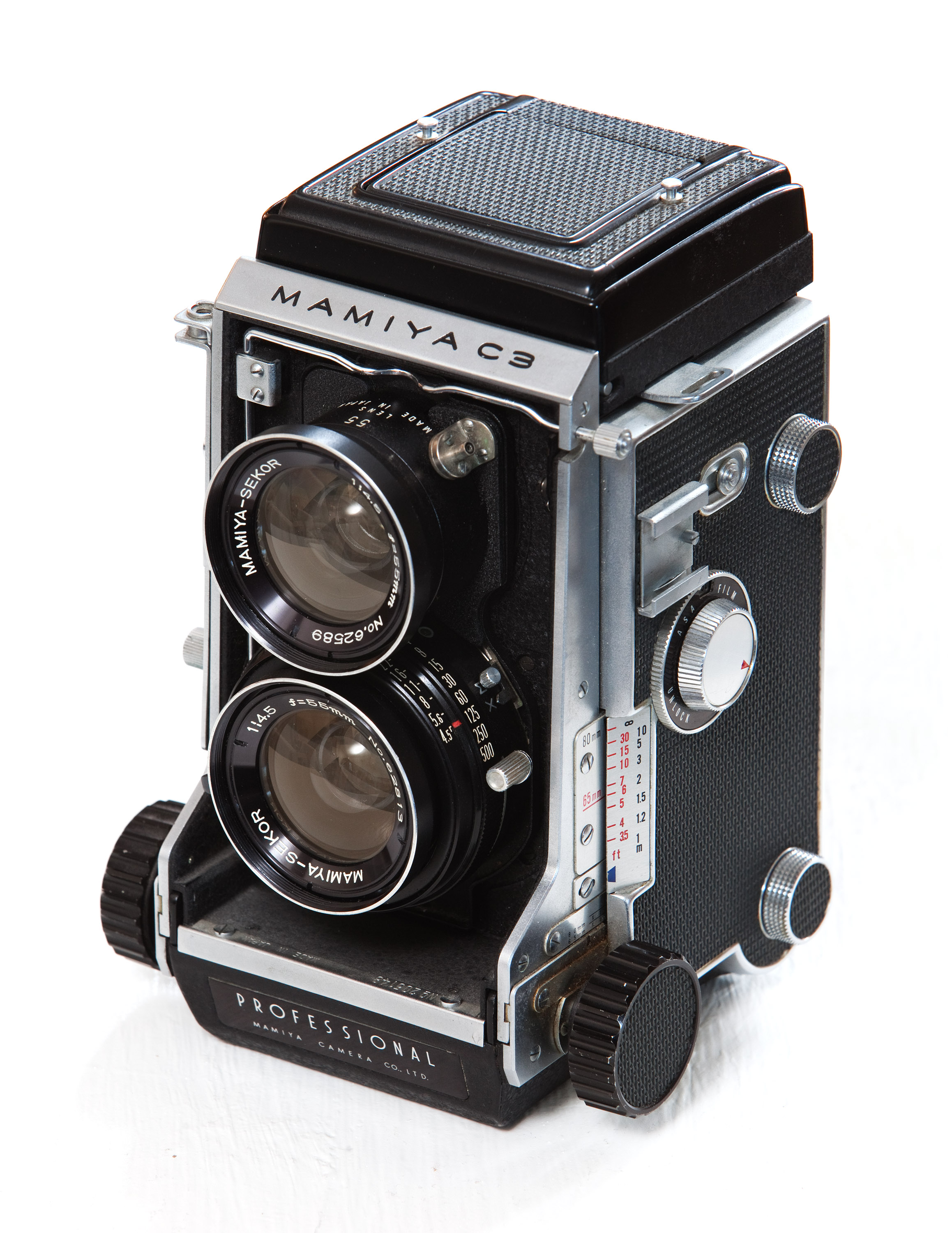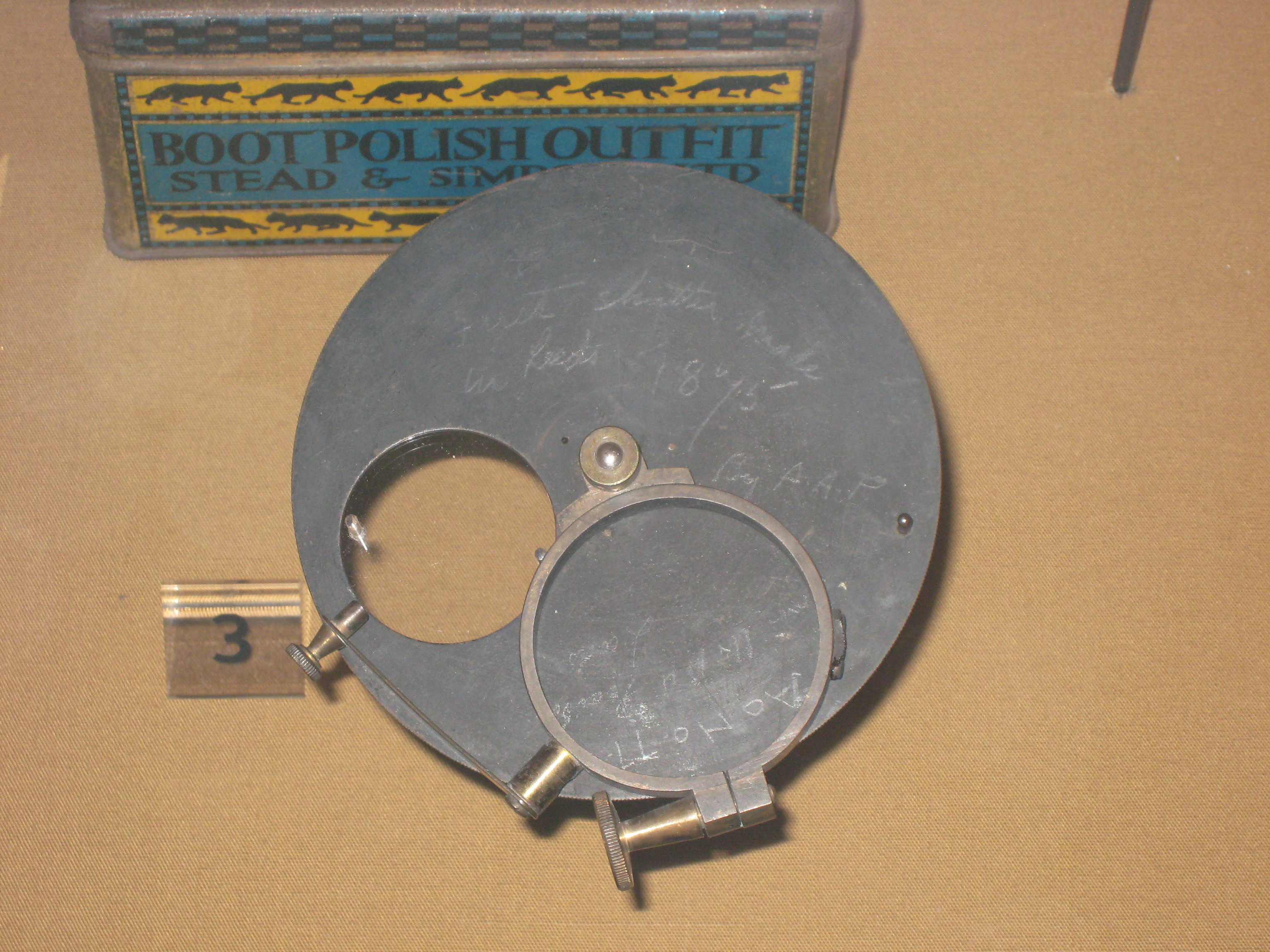|
Mamiya Press
The Mamiya Press is a line of medium-format rangefinder system camera manufactured by Mamiya. The first model was introduced in 1960, and the final model was discontinued in the 1970s. It was targeted at the professional press photography market, and a wide array of accessories was offered. The maximum image size that can be captured is 6 cm × 9 cm, but images can be taken in a number of different formats, and using several types of film. All of the lenses have leaf shutters, which are released on the lens itself, not through the body as is typical with most cameras. The shutter is typically triggered from one of several models of removable grips, all of which have a built-in release cable. The lenses also have flash sync terminals. The camera lacks an internal dark slide, so one has to be inserted into the film holder before changing the lens. Models Mamiya Press The original Mamiya Press was introduced in 1960 with the M-type back attachment system. It came wi ... [...More Info...] [...Related Items...] OR: [Wikipedia] [Google] [Baidu] |
Mamiya
is a Japanese company that manufactures high-end cameras and other related photographic and optical equipment. With headquarters in Tokyo, it has two manufacturing plants and a workforce of over 200 people. The company was founded in May 1940 by camera designer Seiichi Mamiya () and financial backer Tsunejiro Sugawara. History Mamiya originally achieved fame for its professional medium-format film cameras such as the Mamiya Six and the Mamiya Press series. It later developed the industry workhorse RB67 series, the RZ67, the 645 and the twin-lens reflex Mamiya C-series, used by advanced amateur and professional photographers. Many Mamiya models over the past six decades have become collectors' items. The earliest Mamiya Six medium-format folding camera, the 35 mm Mamiya-Sekor 1000DTL, the lightweight 35 mm Mamiya NC1000, the 6×6 cm medium-format C series of interchangeable-lens twin-lens reflex (TLR) cameras, and the press cameras of the Super/Universal seri ... [...More Info...] [...Related Items...] OR: [Wikipedia] [Google] [Baidu] |
Medium-format
Medium format has traditionally referred to a film format in photography and the related cameras and equipment that use film. Nowadays, the term applies to film and digital cameras that record images on media larger than the used in 35 mm photography (though not including 127 sizes), but smaller than (which is considered large format photography). In digital photography, medium format refers either to cameras adapted from medium-format film photography uses or to cameras making use of sensors larger than that of a 35 mm film frame. Some of the benefits of using medium-format digital cameras include higher resolution sensors, better low-light capabilities compared to a traditional 35mm DSLR, and a wider dynamic range. Characteristics Medium-format cameras made since the 1950s are generally less automated than smaller cameras made at the same time. For example, autofocus became available in consumer 35 mm cameras in 1977, but did not reach medium format until ... [...More Info...] [...Related Items...] OR: [Wikipedia] [Google] [Baidu] |
Rangefinder Camera
A rangefinder camera is a camera fitted with a rangefinder, typically a split-image rangefinder: a range-finding focusing mechanism allowing the photographer to measure the subject distance and take photographs that are in sharp focus. Most varieties of rangefinder show two images of the same subject, one of which moves when a calibrated wheel is turned; when the two images coincide and fuse into one, the distance can be read off the wheel. Older, non-coupled rangefinder cameras display the focusing distance and require the photographer to transfer the value to the lens focus ring; cameras without built-in rangefinders could have an external rangefinder fitted into the accessory shoe. Earlier cameras of this type had separate viewfinder and rangefinder windows; later the rangefinder was incorporated into the viewfinder. More modern designs have rangefinders coupled to the focusing mechanism so that the lens is focused correctly when the rangefinder images fuse; compare with the ... [...More Info...] [...Related Items...] OR: [Wikipedia] [Google] [Baidu] |
Leaf Shutter
In photography, a shutter is a device that allows light to pass for a determined period, exposing photographic film or a photosensitive digital sensor to light in order to capture a permanent image of a scene. A shutter can also be used to allow pulses of light to pass outwards, as seen in a movie projector or a signal lamp. A shutter of variable speed is used to control exposure time of the film. The shutter is constructed so that it automatically closes after a certain required time interval. The speed of the shutter is controlled by a ring outside the camera, on which various timings are marked. Camera shutter Camera shutters can be fitted in several positions: * Leaf shutters are usually fitted within a lens assembly (''central shutter''), or more rarely immediately behind (''behind-the-lens shutter'') or, even more rarely, in front of a lens, and shut off the beam of light where it is narrow. *Focal-plane shutters are mounted near the focal plane and move to uncover the fi ... [...More Info...] [...Related Items...] OR: [Wikipedia] [Google] [Baidu] |
Graflex
Graflex was a manufacturer that gave its brand name to several models of camera. The company was founded as the ''Folmer and Schwing Manufacturing Company'' in New York City in 1887 by William F. Folmer and William E. Schwing as a metal working factory, manufacturing gas light fixtures, chandeliers, bicycles and eventually, cameras. In 1909, it was acquired by George Eastman, and the company was moved to 12 Caledonia Avenue (later renamed Clarissa Street), Rochester, NY in 1928, as the Folmer & Schwing Division of the Eastman Kodak Company. In 1926, Kodak was forced to divest itself of the division, which was spun off forming a new company, the Folmer Graflex Corporation, which changed its name to Graflex Inc. in 1946. In 1956, it became a Division of the General Instrument Precision Company, and moved its offices to Pittsford, NY. In 1968, the company was sold to the Singer Corporation. Graflex was known for the quintessential press camera, the Speed Graphic which was manufactu ... [...More Info...] [...Related Items...] OR: [Wikipedia] [Google] [Baidu] |
Speed Graphic
The Speed Graphic was a press camera produced by Graflex in Rochester, Monroe County, New York, Rochester, New York. Although the first Speed Graphic cameras were produced in 1912, production of later versions continued until 1973; with the most significant improvements occurring in 1947 with the introduction of the Pacemaker Speed Graphic (and Pacemaker Crown Graphic, which was lighter and lacked the focal plane shutter). Description Despite the common appellation of ''Speed Graphic'', various Graphic models were produced between 1912 and 1973. The authentic Speed Graphic has a focal plane shutter that the Crown Graphic and Century Graphic models lack. The eponymous name "speed" came from the maximum speed of 1/1000 sec. that could be achieved with the focal plane shutter. The Speed Graphic was available in 2¼ x 3¼ inch, 3¼ x 4¼ inch, 5 x 7 inch and the most common format 4 x 5 inch. Because of the focal plane shutter, the Speed Graphic can also use lenses that do not have s ... [...More Info...] [...Related Items...] OR: [Wikipedia] [Google] [Baidu] |
Image Circle
The image circle is the cross section of the cone of light transmitted by a lens or series of lenses onto the image plane. When this light strikes a perpendicular target such as photographic film or a digital camera sensor, it forms a circle of light – the image circle. Various sensor aspect ratios may be used which all fit inside the same image circle, 3:2, 4:3, 16:9, etc. A lens to be used on a camera that provides movements must have an image circle larger than the size of the image format (Adams 1980, 54). To avoid vignetting, a photographer using a view camera must ensure that the area remains within the image circle (Adams 1980, 56–57; 151–52; 157–61); a tilt/shift lens or perspective-control lens used on a small- or medium-format camera usually has mechanical limitations that keep the frame area within the image circle. See also *Film format *Image sensor format In digital photography, the image sensor format is the shape and size of the image sensor. Th ... [...More Info...] [...Related Items...] OR: [Wikipedia] [Google] [Baidu] |
Instant Film
Instant film is a type of photographic film that was introduced by Polaroid Corporation to produce a visible image within minutes or seconds of the photograph's exposure. The film contains the chemicals needed for developing and fixing the photograph, and the camera exposes and initiates the developing process after a photo has been taken. In earlier Polaroid instant cameras the film is pulled through rollers, breaking open a pod containing a reagent that is spread between the exposed negative and receiving positive sheet. This film sandwich develops for some time after which the positive sheet is peeled away from the negative to reveal the developed photo. In 1972, Polaroid introduced ''integral film'', which incorporated timing and receiving layers to automatically develop and fix the photo without any intervention from the photographer. Instant film has been available in sizes from (similar to 135 film) up to size, with the most popular film sizes for consumer snapshots be ... [...More Info...] [...Related Items...] OR: [Wikipedia] [Google] [Baidu] |
List Of Mamiya Products
This is a list of products made by Mamiya, including cameras and lenses. Models made by Mamiya but marketed under other labels are shown in parentheses. Cameras 16 mm format * Mamiya 16 (1949) * Mamiya Super 16 (1953) * Mamiya Super 16 II (1957) * Mamiya Super 16 III (Tower 16) (1958) * Mamiya 16 Automatic (Revue 16 Automatic) (1959) * Mamiya 16 Deluxe (1961) * Mamiya 16 EE Deluxe (1962) 126 format * ( Argus 260 Automatic) (1964) * ( Keystone K1020) (1966) — fixed-lens single lens reflex 35 mm format Rangefinder * Mamiya 35 I (1949) * Mamiya 35 II (1955) * Mamiya 35 III (1957) * Mamiya Magazine 35 (1957) * Mamiya Wide (1957) * Mamiya Elca (1958) * Mamiya Crown (1958) * Mamiya Metra (1958) * Mamiya S (1958) * Mamiya Wide E (1959) * Mamiya Auto Metra (1959) * Mamiya Metra 2 (1959) * Mamiya Auto Metra 2 (1959) * Mamiya Sketch (1959) — square image format (24mm × 24mm) * Mamiya S2 (1959) * Mamiya Ruby (1959) * Mamiya Auto Deluxe (1960) * Mamiya Ruby Standard (1961) * Mamiy ... [...More Info...] [...Related Items...] OR: [Wikipedia] [Google] [Baidu] |
Mamiya Rangefinder Cameras
is a Japanese company that manufactures high-end cameras and other related photographic and optical equipment. With headquarters in Tokyo, it has two manufacturing plants and a workforce of over 200 people. The company was founded in May 1940 by camera designer Seiichi Mamiya () and financial backer Tsunejiro Sugawara. History Mamiya originally achieved fame for its professional medium-format film cameras such as the Mamiya Six and the Mamiya Press series. It later developed the industry workhorse RB67 series, the RZ67, the 645 and the twin-lens reflex Mamiya C-series, used by advanced amateur and professional photographers. Many Mamiya models over the past six decades have become collectors' items. The earliest Mamiya Six medium-format folding camera, the 35 mm Mamiya-Sekor 1000DTL, the lightweight 35 mm Mamiya NC1000, the 6×6 cm medium-format C series of interchangeable-lens twin-lens reflex (TLR) cameras, and the press cameras of the Super/Universal se ... [...More Info...] [...Related Items...] OR: [Wikipedia] [Google] [Baidu] |







